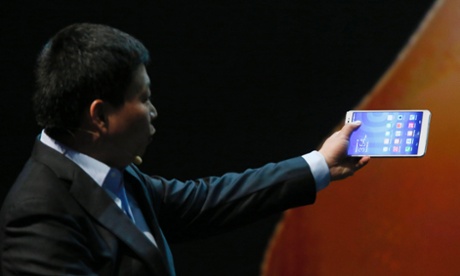
Sales of Apple’s 5C “plastic” phone are beginning to improve after price cuts, while “phablet” phones with screens over 5in are not a hit with users in Europe, according to new data from Kantar Comtech.
Meanwhile the figures for the three months to the end of January 2014 show that Android is heading for a 70% share of phone sales in Europe, though Samsung is seeing its dominant share of Android sales being eroded by rivals including LG, Sony, Motorola and newcomer Wiko.
Microsoft’s Windows Phone has also managed to maintain a share over 10% for the past six months aggregated across the “EU5” - the five largest EU countries, comprising Germany, the UK, Spain, France and Italy. However that disguises wide national variations: in Italy its share has been over 16%, while in Spain and Germany it has been around 5%. In the UK and France it has been around 11%.
For BlackBerry, though, the figures brought no comfort, with its share of sales halving in the US, EU5 and Australia, to zero in Spain and Japan (from 2.1% and 0.3% respectively). The UK remains its strongest market, with a 2.4% share of sales - but even that is halved from 5.7% a year ago.
The latest figures are not indexed, so they don’t reflect the growth in the size of the smartphone market from year to year. In 2013, the world smartphone market including China grew by 38.4%; excluding China, the figure was smaller, at around 22%, though developed countries have been seeing a slowdown in sales growth as markets head towards saturation.
UK: a four-phone race?
Kantar said that price cuts had begun to see the coloured iPhone 5C gain sales, after falling behind the higher-priced 5S model: “When Apple first launched its new iPhones in Britain the 5S outsold the 5C by 3:1,” it said in a note.
“However, the iPhone 5C has gained momentum and was the third best-selling smartphone [in Britain] over the past three months, reducing the 5S/C ratio to 2:1. There is a stark gender divide between 5C and 5S buyers – in Britain 74% of 5C buyers are female versus just 36% for the 5S. There are also clear differences in how each device is used: 5S users are more engaged with their device, particularly for data-heavy functions such as watching mobile TV or downloading music.”
The two handsets which outsold the 5C are the iPhone 5S and the Samsung Galaxy S4, though Kantar didn’t specify which of the latter two sold better. Apple’s UK share fell very slightly, from 31% to 30.7% of sales, while that for Android also fell slightly from 55.9% to 55.2%. The biggest gainer was Windows Phone which saw its share nearly double from 6.4% to 11.3% in the period which covers the two busiest sales months of the year.
But comparisons are difficult: UK smartphone penetration has risen over that period, from 62% then to 70% now, while smartphone sales have risen from 83% of all phone sales to 86%. They point though to growth in Windows Phone sales: Kantar says that the low-end Nokia Lumia 520 was the fourth best-selling handset in the UK, “only just behind” the iPhone 5C.
Dominic Sunnebo, strategic insight director at Kantar, commented that there are still 14 million featurephone owners who could be tempted to trade to a smartphone, and that the Nokia strategy - which will soon become Microsoft’s, when the takeover is complete - could pay off: “At some point Nokia will have to start making serious inroads into the smartphone competition, but for the time being its strategy in Europe is working. Crucial for Nokia will be its ability to keep low-end owners loyal and upgrade them to mid to high-end models.”
Phablet differences
Sales of phones with screens measuring over 5in diagonally - aka “phablets” - continue to drive strong growth in China, making up almost a third of smartphones sold there in the three months, and 9% had screens over 5.5in. Other research companies have suggested that sales in China during the fourth quarter (from October to December) were 90m - suggesting about 30m sales of phablets, including 8.1m with 5.5in screens or larger.But Kantar warned that there are serious differences between locations. “Phablet sales across Europe and US have been gradually rising, but it’s China which is driving demand. Phablet owners are less likely than the average consumer to own a tablet, indicating that phablets are increasingly being used as the primary device to browse online in China.
“Interestingly, phablet ownership in China is skewed heavily to women, running counter to Europe and the US where it tends to be young, male early adopters.”
He reiterated data previously supplied to the Guardian about how the first European owners of phablets are now coming to the end of their first contracts - and that a significant number, 40%, are choosing to get a smaller device.
The data from Kantar suggests that over time the phone market will tend towards one where phablet owners make up about 40% of users, those with devices between 4.5in and 4.9in (about the size of the HTC One) make another 40%, and those with screens between 4in and 4.4in (such as the present lineup of iPhones) make up the other 20%.
Rumours increasingly suggest that Apple will produce at least one phone with a larger screen this year - perhaps as large as 4.7in or even 5.5in as buyers show a growing tendency to move towards larger screens, and a diminishing tendency to buy smaller ones.

